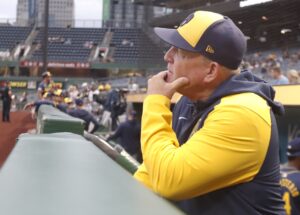On Friday, July 5, the New York Yankees are holding Seinfeld Night, complete with a George Costanza Bobblehead Giveaway. We mark the occasion with a discussion of those Yankees who’ve shown the same qualities (or lack thereof) as George Costanza. So, sit back and revel in these tales of cheapskates, cheaters, narcissists, do-nothings, and misers.
Introducing The All-George Costanza Yankees Team
Ruth, Gehrig, DiMaggio, Mantle… Costanza?!?
Join us at Yankee Stadium on Friday, July 5 for Seinfeld Night! 1st 18,000 guests will receive a George Costanza Bobblehead 🎟️👉 https://t.co/3T93wcJJ4j pic.twitter.com/fEdq8NJxp1
— New York Yankees (@Yankees) March 15, 2024
Criteria For The All-George Costanza Yankees Team
For the benefit of those scant few readers who never saw Seinfeld, George is Jerry Seinfeld’s long-time best friend. According to his page on WikiSein, George is neurotic, “bitter, miserly, selfish, greedy and dishonest.” His psychological problems include “sociopathy . . . narcissism, habitual lying, low self-esteem, sudden fits of anger, hypochondriasis, impulsive acts of ill-considered cheapness, selfishness, obsessiveness, (and) living in fantasy.” George’s insecurity often causes him to sabotage relationships. Although bravery is not one of his traits, he frequently shows courage and overconfidence at the worst times, usually to impress a woman he had lied to. We looked for these characteristics in assembling our Yankees All-George Costanza Team.
The Master Of Self-Sabotage
Who but Billy Martin could be the manager of the Yankees All-George Costanza team? Over his 19-year managerial career, Martin had a reputation as a sharp manager who turned around losing teams remarkably fast. Yet, except for getting the Yankees to the World Series in 1976 and 1977, winning the latter, he was never around to see any of his teams win a championship. He usually sabotaged those relationships before his teams could get that far.
Before becoming the Yankees manager in 1975, he had managed the Minnesota Twins, Detroit Tigers, and Texas Rangers. With the Twins, he brawled with pitcher Dave Boswell outside a Detroit bar and ordered former United States Vice President Hubert Humphrey out of the clubhouse. With the Tigers, he feuded with star slugger Willie Horton. He publicly criticized his bosses at all three stops for knowing nothing about baseball.
Yankees owner George Steinbrenner had a high opinion of Martin’s managerial skills. All that could cost Martin his Yankees job were insubordination and embarrassing off-field incidents. However, in true George Costanza fashion, Martin gave the Yankees plenty of both.
“One’s A Born Liar, The Other’s Convicted”
When Reggie Jackson came to the Yankees in 1977, Martin continued his tradition of warring with his team’s star. They co-existed in 1977 – mostly.
But Martin and Jackson couldn’t live in peace and harmony forever. In Kansas City in 1978, Jackson defied Martin’s orders and attempted, unsuccessfully, to lay down a sacrifice bunt. Martin suspended Jackson for insubordination, a decision supported by Steinbrenner. However, a few days later, Martin told the media regarding Jackson and Steinbrenner, “The two of them deserve each other. One’s a born liar, the other’s convicted,” referring to Steinbrenner’s guilty plea for making illegal campaign contributions to Richard Nixon in 1974. (In a refrain all too familiar to this writer, Steinbrenner blamed his attorneys.) Shortly after that, Martin was dismissed.
Martin was rehired to manage the Yankees in the middle of the 1979 season. He then made baseball history by becoming the only manager ever fired for sucker-punching a marshmallow salesman. Rehired again in 1983, he didn’t get along with his players. Rehired again in 1985, he was involved in two barroom brawls, one with pitcher Ed Whitson. Martin was hired and fired five times as Yankees manager, with a stint as the Oakland Athletics manager between “Billy II” and “Billy III” in New York. The Athletics’ owners fired him, too, after he asked them to pay his back taxes.
Jackson was a George Costanza-level narcissist who angered his Yankees teammates by proclaiming to Sport that he was “the straw that stirs the drink” upon his arrival in 1977. Catfish Hunter once said of Jackson, “He’d give you the shirt off his back. Of course, he’d call a press conference to announce it.”
Working On The Pensky File
Yankees manager Joe Torre couldn’t shake the image of the bulldog pitcher for the Florida Marlins. He was Carl Pavano, and he helped Florida defeat the favored Yanks in the 2003 World Series. Pavano pitched nine innings in two games (one start), surrendering just one run. As the Yankees would later do with Jacoby Ellsbury and Johnny Damon, they signed Pavano when he became available. Their philosophy was if you can’t beat ‘em, join ‘em – or, more accurately, pay ‘em to join you. Thus, in December 2004, they gave Pavano a four-year, $39 million contract. “Number one, he wants to win,” his agent, Scott Shapiro, told the press.
Instead, this Yankees pitcher gave a George Costanza-like performance with the Pensky file. In four years with New York, Pavano pitched in just 26 games, going 9-8 with a 5.00 ERA. He didn’t pitch at all in 2006. There was a right shoulder injury in June 2005. He bruised his butt in spring training 2006. By the time he was ready to pitch a major league game in August, he suffered two broken ribs in a car accident. After pitching in two games to start the 2007 season, he strained his elbow and required Tommy John surgery. He returned to a major league mound to finish his time with the Yanks in August 2008.
Pavano’s constant health issues annoyed even the unflappable Derek Jeter. According to Torre’s book, The Yankee Years, Jeter walked by Pavano in the clubhouse and asked, “Hey, Pav. You ever going to play? Ever?”
“Did You Fill It Up with Gas?”
The great Joe DiMaggio’s legendary greed and frugality were detailed in Richard Ben Cramer’s biography, Joe DiMaggio: The Hero’s Life. DiMaggio never reached for a dinner check. When given a free Cadillac, he asked, “Did you fill it up with gas?” When invited to celebrity golf tournaments, he told the promoters he had no clubs of his own and they’d have to provide them. Thus, he had a garage full of sets of clubs sitting in golf bags. A blogger who goes by Train Writer writes of sending DiMaggio a picture to sign. DiMaggio returned the signed picture, but postage is due.
Rivaling DiMaggio for George Costanza-cheapness is the entire 1976 Yankees team. That team was swept by the Cincinnati Reds in the World Series. The Reds had voted to give their home batboys a quarter share, or $6,591 each, of their World Series money. Conversely, the Yankees voted their batboys out of a share of their World Series money. Responding to backlash over the matter, the players then agreed to send them $100 each out of a fund from players’ fines. Highest honors go to pitcher Sparky Lyle, who was responsible for sending the checks. He didn’t get around to it until the following February. Three of the four refused the checks.
Liars And Cheaters
We’ll eschew any discussion of those accused of using PEDs here. By now, that’s boring stuff. There are more fun stories to tell. There was Graig Nettles, suspended for using a bat filled with six superballs on September 7, 1974. The Yankees third baseman broke his bat when he hit an infield single, later disallowed, against the Tigers. Detroit catcher Bill Freehan retrieved the superballs when the bat shattered. Nettles was handed a 10-game suspension. He claimed a fan in Chicago gave him the bat.
Just as George Costanza-ish in his lying was Yankees shortstop Jeter on September 15, 2010, in Tampa Bay. After a pitch from Rays pitcher Chad Qualls hit the knob of Jeter’s hat, he pretended he was hit in the hand by the pitch and awarded first base. Jeter rationalized it, saying, “(The umpire) told me to go to first base. I’m not going to tell him I’m not going to first, you know.”
“Mick” And His Co-Conspirators
Previously, there was September 19, 1968, at Tiger Stadium. The Tigers were ahead, 6-1, in the eighth inning. Mickey Mantle stepped to the plate for his final appearance in Detroit. The Tigers were well on their way to the American League pennant while pitcher Denny McLain was on his way to a 31-win season. Thus, McLain and catcher Jim Price conspired to let Mantle hit a home run.
Price crouched behind the plate and told Mantle to expect nothing but fastballs down the middle. Mantle took two strikes and signaled to McLain to get the ball out over the plate more. On the next pitch, he launched career home run No. 535 into the upper right-field stands. Mantle could be seen shouting “thanks” as he rounded third. McLain replied with a smile and a salute. The next Yankees batter, Joe Pepitone, signaled where he would like the first pitch. McLain fired a fastball at his head.
Like a pitcher who had intentionally hit a batter, McLain denied everything. He told the media, “Mickey has been my No. 1 idol since I was a kid, but I didn’t groove it for him.” Price said, “Mantle was just kidding by his motions.”
A Bad Time For Overconfidence
Finally, let’s go back to Game 7 of the 1926 World Series for a tale of George Costanza-like overconfidence on the part of two Yankees legends. The St. Louis Cardinals were ahead, 3-2, in the ninth inning at Yankee Stadium. Grover Alexander was on the mound for the Cards. All he did in that Series was pitch to a 2-0 record and a 1.33 ERA. In his third inning of relief, he hadn’t allowed a baserunner until Babe Ruth walked with two outs.
With Bob Meusel at-bat, Ruth took off for second base as Meusel swung and missed Alexander’s offering. Catcher Bob O’Farrell nailed the sliding Ruth with a perfect throw, ending the Series. Accounts differ as to whether Ruth was stealing on his own or Meusel had put on a hit-and-run. In any event, it was a foolish episode of overconfidence at the worst possible time. Alexander was a future Hall-of-Fame pitcher who would win 373 games with a lifetime ERA of 2.56. O’Farrell had thrown out an astounding 48 percent of runners attempting to steal over his long career.
Are we really going so far as to compare “The Babe” to George Costanza? Hey, we did it with DiMaggio and Mantle. There are no sacred cows here.
Yada Yada Yada
Honorable mention goes to 11-year major league catcher Clint Courtney, who played for the Yankees in 1951. He had no discernible George Costanza traits except for a strong resemblance to the character.
George Costanza bobbleheads will be given only to the first 18,000 fans to enter Yankee Stadium to see the Yankees battle the Boston Red Sox on the appointed date. The first pitch is scheduled for 7:05 PM. Gates normally open 90 minutes before game time. In baseball, as in life, these details are subject to change.
Main Photo Credits: Kevin R. Wexler/NorthJersey.com / USA TODAY NETWORK






